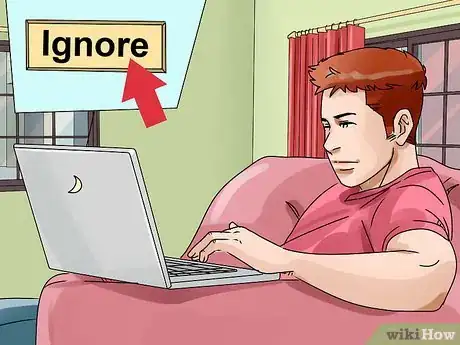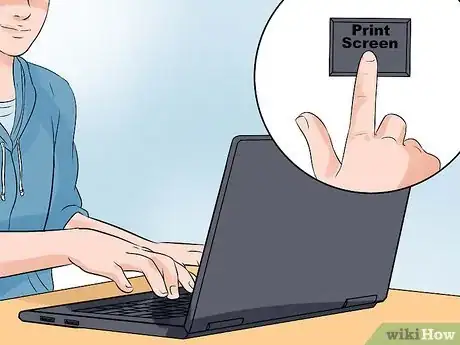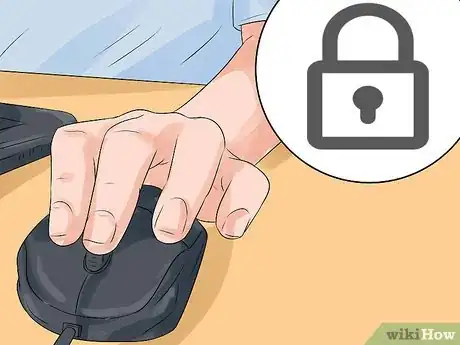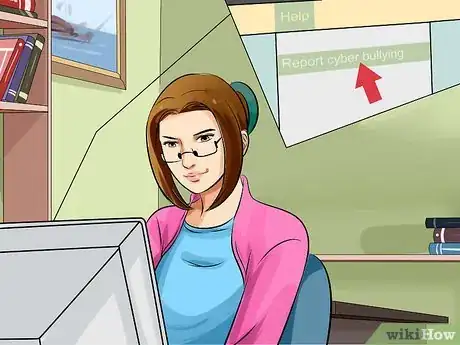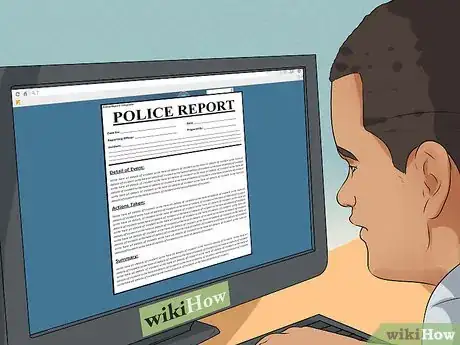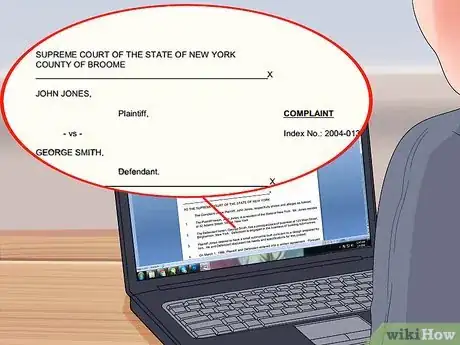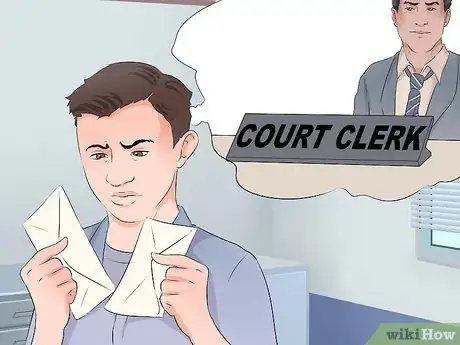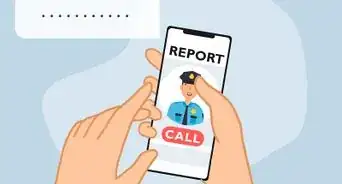This article was written by Jennifer Mueller, JD. Jennifer Mueller is an in-house legal expert at wikiHow. Jennifer reviews, fact-checks, and evaluates wikiHow's legal content to ensure thoroughness and accuracy. She received her JD from Indiana University Maurer School of Law in 2006.
This article has been viewed 52,619 times.
The internet can be a powerful tool for sharing information and ideas with people all over the world. Unfortunately, many people use this tool to bully, harass, and intimidate others. Using the internet in this way violates federal law and the law of most states, but it often is very difficult to prosecute the perpetrators. If you are the victim of this sort of behavior online, you can take legal action against cyber bullying to help bring the person to justice and protect others from becoming victims as well.
Steps
Protecting Your Personal Safety
-
1Avoid responding directly to the person bullying you. Although it can be difficult, engaging the bully typically only encourages him or her to continue or even escalate the attacks against you. This includes making any public online statements about the situation.[1] [2]
- You may want to make an initial statement telling the person to stop. If you do, make a statement in a calm manner and don't respond further.
- More likely than not, the person will use your direct contact as an excuse to try to bait you into arguments or to continue to harass and insult you.
- Keep in mind that many bullies often are looking for attention. If you start attacking the bully, or encourage your friends to attack them, you're playing the bully's game, giving them exactly what they want.
- Responding to the bully also runs the risk that you will begin insulting and harassing him or her as well, which can hurt your case when you attempt to take legal action against the cyber bullying.
-
2Maintain a record of the bullying. One of the biggest difficulties police and prosecutors have with arresting and prosecuting online bullying is proving that the conduct was taking place. Because victims often don't keep records of their interactions with bullies, the situation too often comes down to a case of "he said, she said." [3] [4] [5]
- If the person sends you emails or direct messages, save those messages in their entirety.
- You also want to take screen captures of the messages or comments on posts. Make sure you can read the messages clearly in your images.
- If you don't know how to make screen captures on your computer, search for instructions online or in the help file of your computer's image or photo application.
- Make sure you record the dates and times of the messages or comments. If friends of yours have seen the messages as well (such as if they are comments on social media posts visible to your followers), ask them if they'd be willing to testify as to the content of those messages.
Advertisement -
3Block the person bullying you. It may sound simplistic, but most websites and social media networks have methods by which you can block users who are bothering you. Typically, you won't be able to see any posts or comments from people you've blocked, and they won't be able to see yours.[6]
- Particularly on social media networks, go to your account preferences and look for the options dealing with safety or security. Typically there will be a place where you can enter a username and block that account.
- On some websites you may be able to block the person simply by clicking on his or her name or icon and following the prompts.
- Keep in mind that this method only works when you are logged in to your account, and it doesn't prevent the person from opening a new account and using it to bully you, once he or she finds out you blocked the original account.
-
4Consider closing your account or taking other steps. If the bullying or harassment is only happening on one website, and the bully has shown no signs of following you anywhere else or attempting to disrupt your life off-line, you may be able to get rid of him or her by temporarily closing your account on that website.
- Keep in mind that your ultimate goal should be to get the bullying to stop – not to take revenge against the person bullying you, but to restore your ability to use the internet in peace.
- If the website where you've become a target for cyber bullying is not that important to you, consider leaving the website, or starting a new account under a different username.
- In some cases this might not be a legitimate option for you, particularly if you are being bullied on a social media site you use to connect to family and friends who live far away. The decision ultimately is yours – no one can force you to take down your account because someone else is bullying you.
- If you're contributing content to a website or blog run by someone else, you may be able to contact the company and have comments closed on your posts, or have your posts removed.
Reporting to Online Service Providers
-
1Gather information about the interactions. Before an online service provider can take action against someone who is bullying you, it must have account information for you and the person who is bullying you, as well as evidence of the comments or conduct that has taken place.[7] [8]
- Typically you will need to provide evidence of the comments or messages to get the online service provider to take action. You probably will have the ability to attach digital images such as the screen-caps you took.
- You also should take a moment to write a chronological summary of the events that took place and the pattern of bullying you experienced.
- This summary will not only help you file a complaint against the bully with the website, but also when you file a report with the police or work on filing a civil lawsuit.
-
2Contact the website where the bullying occurred. Most websites and social media networks have contact information, typically an email address, that you can use to alert the company about the bullying you've experienced. [9]
- Some websites may have a form you can fill out and submit online that provides basic information about the bullying you've experienced and what you want the website to do about it.
- Once you complete this initial form, it will be reviewed by the website's employees and someone will contact you, typically through email, to ask for further information.
- If you don't receive a response within a reasonable period of time, you may want to contact the website again. Some websites take longer to respond than others, but there's no reason why more than a week should go by without you receiving some response.
-
3File a formal complaint. In most cases, bullying violates a website's terms of service, which all users agree to follow when using the website. The website will take action against users who violate its terms of service. [10] [11]
- Read through the site's terms and conditions and other community guidelines, and make a list of the clauses or terms that your bully has violated through his or her communication.
- When you send your formal complaint, list these terms specifically, using their number or title. Then point to the exact message or comment in violation of that term.
- Include as much evidence as you have to back up the statements you make, such as screen-captures or permalinks to posts where the bully's comments appear.
- Typically a formal complaint against another user also must include your own personal information, such as your full legal name, email, and mailing address. You may want to include a statement that you don't want this information shared with the person you're reporting.
-
4Follow up on your complaint. Once the online service provider has reviewed your complaint, you typically will get a notice letting you know what the website's representative found and what actions were taken as a result.[12]
- Don't be surprised if you get a message back telling you to simply block the person. If you've previously taken such steps, you should let the website know.
- You also may want to let the website know that the person is harassing or bullying other people from the same account, if you have any evidence that this is true.
- The website also may tell you that if you feel personally threatened, you should file a complaint with your local law enforcement.
Reporting to Law Enforcement
-
1Gather evidence of the bullying behavior. Often if you want the local police to do anything about the cyber bullying you are experiencing, you must be able to prove that the person knows where you live and presents a threat to your life or well-being.[13] [14]
- Often, cyber bullying must be prosecuted under other laws that prohibit stalking, threats, or harassment. The type of evidence required to prove these crimes varies.
- To learn more about the anti-bullying laws in your state, you can visit http://www.stopbullying.gov/laws/ and click on your state on the map.
- You may want to print copies of the laws against cyber bullying in your state and take them with you when you go to file your report.
- Police typically are reluctant to get involved unless you are concerned for your safety, so focus your evidence on anything that would demonstrate a local contact or an intent to physically harm you or your family.
- Keep in mind that typically it is not enough to show a single message, or even an isolated string of messages or comments. You must be able to show a pattern of continuous behavior.
- If you have a friend or family member who lives nearby and is familiar with the bullying you've experienced online, you may want to ask them to come to the police station with you for support.
-
2Visit your nearest law enforcement agency. Take all of the information you've gathered about the cyber bullying you're experiencing and the person responsible for it to your local police precinct and ask to file a police report. [15] [16]
- Keep in mind that some officers may not understand cyber bullying, or realize that the behavior is against the law.
- If you've brought copies of your state's criminal law, show them to an officer and insist on filing a police report.
-
3Speak to an officer. After you've filed a report, you typically will be interviewed by an officer who will ask you questions about your report and give you a timeframe for any investigatory process that the police will undertake.[17]
- A police investigation is most likely if you know the identity of the person bullying you online, and know that they live nearby or have the ability to cause you harm "in real life" – not just in the online world.
- If the person is an anonymous user or not someone you know, on the other hand, it may be very difficult to get the police to act on your report. However, it's still important that you have a report on file in the event something else happens.
- Make sure you get the name of the officer who takes your report, and get a copy of your written report for your records before you leave the police station. Your report typically will have a number for you to use if you call for updates.
-
4Follow up on your report. If a few weeks go by and you haven't heard anything from the police regarding your report, call the station and ask about it. You also want to let an officer know if you acquire additional evidence concerning your case.[18]
- In many cases, persistence pays off. Tell the police officer with whom you speak that you want the case against the person to be prosecuted.
- You might also consider calling the district attorney's office and telling them about your case. Provide a copy of your police report and let the district attorney know that you understand the person's actions are against the law and you want him or her prosecuted for it.
Filing a Civil Lawsuit
-
1Hire an attorney. If you've decided you want to file a civil lawsuit against the person bullying you, an experienced personal injury attorney may be your best option to ensure you recover the maximum amount in damages.[19] [20]
- Damages in civil lawsuits for cyber bullying typically hinge on emotional distress, and can be extremely difficult to prove. An attorney with experience litigating these cases will have a good idea what your case is worth and the types of damages that can be proven.
- In many cases, a personal injury attorney will take your case on a contingency-fee basis, meaning you won't have to pay any attorney's fees unless you settle the case or are awarded monetary damages in court.
- For this reason, if you plan to file a civil lawsuit it's in your best interest to have a lawyer on your side.
-
2Draft your complaint. A complaint is the document you'll file with the court to sue your bully, and will list your factual allegations against the person and explain why those facts add up to a legal wrong for which you can sue the person.[21]
- Your attorney will need information about the bullying to craft the allegations for your complaint. The evidence that you've gathered will help, as well as any reports you've filed with the police and online service providers.
- Your attorney also will likely want to know about your relationship with the person who is bullying you, including whether you know them personally and how they came into your life.
- Typically, your complaint will be based on a cause of action such as defamation or intentional infliction of emotional distress. For either of these causes of action to succeed, the bully's statements must be extreme – annoyances or vague insults aren't enough.
- Your attorney will go over the complaint with you before filing it. Make sure you understand everything in the document and that the allegations are correct.
-
3File your complaint. To initiate your lawsuit, you must take your original complaint, along with several copies, to the clerk's office of the court where you want your case to be heard. If all of your documents are in order, the clerk will file your complaint once you've paid the court's filing fee.[22]
- The court will charge filing fees when you file your complaint. If your attorney is working on contingency, you typically won't have to pay those fees yourself. Rather, your attorney will pay them and add them to the costs of your lawsuit, which will be recovered if you win or settle the lawsuit.
- Once the complaint is filed, it must be served on the person you're suing. Typically this involves either having the complaint and summons hand-delivered by a sheriff's deputy, or having them delivered using certified mail.
- After service is completed, the bully must answer your lawsuit before the court's deadline or you may be eligible to win your lawsuit by default.
- However, keep in mind that even if you file a motion for default, you typically still have to prove that you are entitled to the damages you've requested.
-
4Litigate your lawsuit. If the bully files an answer to your lawsuit, you will begin pretrial litigation, during which you will gather information and prepare for the trial. During this time you also may have the opportunity to settle your lawsuit.[23] [24]
- Discovery may become one of the most important parts of this phase of litigation. Through written questions and depositions, you have the chance to ask the bully about his or her motivations and goals in harassing you.
- Through requests for production, you also have the opportunity to find out if the bully was also bullying or harassing other people, and what was being said about you to others.
- Keep in mind that lawsuits are expensive, stressful, and time-consuming. These realities can become huge factors when considering the value of a settlement offer.
- As angry as you may be, and as tempted as you may be to go all the way to trial just for "the principle of the thing," a trial – whether by judge or jury – carries no guaranteed result.
References
- ↑ http://www.stopbullying.gov/cyberbullying/how-to-report/
- ↑ http://cyberbullying.org/advice-for-adult-victims-of-cyberbullying/
- ↑ http://www.stopbullying.gov/cyberbullying/how-to-report/
- ↑ http://www.crfcap.org/images/pdf/cyberbullying.pdf
- ↑ http://cyberbullying.org/advice-for-adult-victims-of-cyberbullying/
- ↑ http://www.stopbullying.gov/cyberbullying/how-to-report/
- ↑ http://www.stopbullying.gov/cyberbullying/how-to-report/
- ↑ http://cyberbullying.org/advice-for-adult-victims-of-cyberbullying/
- ↑ http://cyberbullying.org/advice-for-adult-victims-of-cyberbullying/
- ↑ http://www.stopbullying.gov/cyberbullying/how-to-report/
- ↑ http://cyberbullying.org/advice-for-adult-victims-of-cyberbullying/
- ↑ http://cyberbullying.org/advice-for-adult-victims-of-cyberbullying/
- ↑ http://www.stopbullying.gov/cyberbullying/how-to-report/
- ↑ http://www.crfcap.org/images/pdf/cyberbullying.pdf
- ↑ http://www.stopbullying.gov/cyberbullying/how-to-report/
- ↑ http://www.crfcap.org/images/pdf/cyberbullying.pdf
- ↑ http://jacksonandwilson.com/bullying/
- ↑ http://jacksonandwilson.com/bullying/
- ↑ http://cyberbullying.org/advice-for-adult-victims-of-cyberbullying/
- ↑ http://jacksonandwilson.com/bullying/
- ↑ http://www.crfcap.org/images/pdf/cyberbullying.pdf
- ↑ http://jacksonandwilson.com/bullying/
- ↑ http://www.crfcap.org/images/pdf/cyberbullying.pdf
- ↑ http://cyberbullying.org/advice-for-adult-victims-of-cyberbullying/
